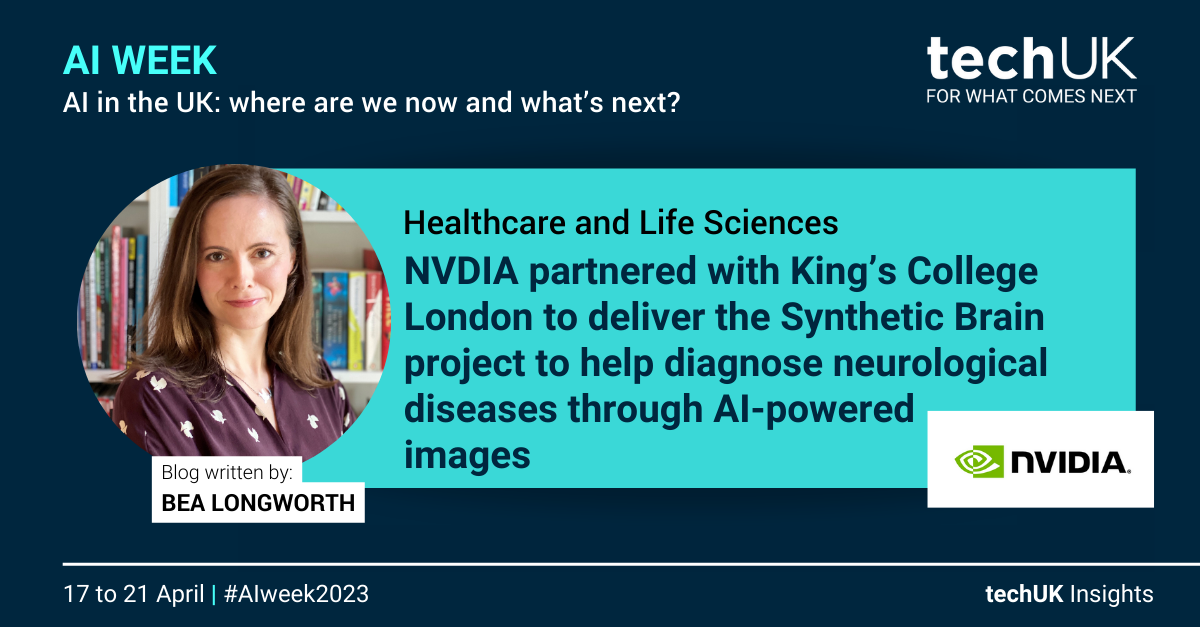NVDIA partnered with King’s College London to deliver the Synthetic Brain project to help diagnose neurological diseases through AI-powered images (Guest blog by NVIDIA)
Challenge: Diagnosing neurological diseases more effectively
The Synthetic Brain Project, a collaboration between NVDIA and King’s College London, is focused on building deep learning models that can synthesise artificial 3D MRI images of human brains. This is helping researchers to accelerate their work by dramatically increasing the amount of data available. In turns, this aims at developing AI models to help diagnose neurological diseases based on brain MRI scans. They also could be used for predicting diseases a brain may develop over time, enabling preventative treatment.
The use of synthetic data has the additional benefit of ensuring patient privacy and gives King’s College the ability to open the research to the broader UK healthcare community.
Solution: synthetic data to make brain images more accessible
Over 100,000 synthetic brain images generated by the application have been made available for free for healthcare researchers to help them understand dementia, aging and other sorts of brain disease.
While it is artificial, synthetic data reflects real-world data, mathematically or statistically. Research demonstrates it can be as good or even better for training an AI model than data based on actual objects, events or people. The use of synthetic data in healthcare research helps address some key risks in applying AI for healthcare, such as the availability of large amounts of high-quality labelled data, preserving data privacy, ensuring data represents a diverse cross-section of individuals, and enabling the creation of plentiful data on rare diseases. As part of the synthetic brain generation project from King’s College London, the code and models are open-source. NVIDIA has made open-source contributions to improve the performance of the fast-transformers project, upon which The Synthetic Brain Project depends.
Barriers: Lack of access to diverse sets of medical images
Synthetic data is annotated information that computer simulations or algorithms generate as an alternative to real-world data. This technique already widely used in computer vision for consumer and business apps. These fields tend to have access to open datasets with millions of real-world images. By contrast, medical images are relatively scarce, typically only available to researchers connected to large hospitals, given the need to protect patient privacy. Even then, medical images tend to reflect the demographics the hospital serves, not necessarily the broader population. This has been a major barrier preventing researchers from applying AI to their work.
Impact: AI-created brain images to support research
The UK Biobank maintains multiple brain images taken from more than 50,000 participants, curated at an estimated cost of $150 million. The researchers responsible for the Synthetic Brain Project have already tripled this resource with their donation of 100,000 synthetic brain images to Health Data Research UK, a national healthcare data repository which will host the images. The AI models will also be available so researchers can create whatever images they need. A fortunate feature of this AI approach is it can make images to order, helping researchers ensure their research is based on diverse datasets. Though the brain images are simulated, they are highly useful because they preserve key biological characteristics.
Creating generative brain images that are eerily similar to real life neurological radiology studies helps understand how the brain forms, how trauma and disease affect it, and how to help it recover. Instead of real patient data, the use of synthetic data mitigates problems with data access and patient privacy.

AI and Data Analytics updates
Sign-up to our monthly newsletter to get the latest updates and opportunities from our AI and Data Analytics Programme straight to your inbox.

